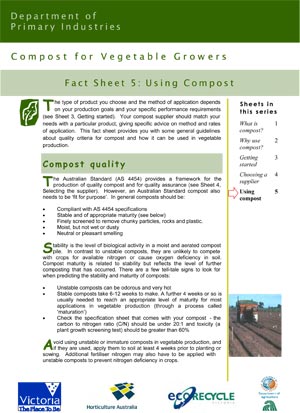|
This is the last in a series of five fact sheet developed for vegetable growers in 2003 – 2004.
These sheets will provide you with information about composting, compost products and how to best use them to suit your needs.
The type of product you choose and the method of application depends on your production goals and your specific performance requirements.
Your compost supplier should match your needs with a particular product, giving specific advice on method and rates of application.
This fact sheet provides you with some general guidelines about quality criteria for compost and how it can be used in vegetable production.
Authors
|
Kevin Wilkinson
|
Dean Harapas
|
Emily Tee
|
Bruce Tomkins
|
Robert Premier
|


Compost Quality :
The Australian Standard (AS 4454) provides a framework for the production of quality compost and for quality assurance. However, an Australian Standard compost also needs to be ‘fit for purpose’.
In general composts should be:
- Compliant with AS 4454 specifications
- Stable and of appropriate maturity
- Finely screened to remove chunky particles, rocks and plastic
- Moist, but not wet or dusty
- Neutral or pleasant smelling
Stability is the level of biological activity in a moist and aerated compost pile.
In contrast to unstable composts, they are unlikely to compete with crops for available nitrogen or cause oxygen deficiency in soil.
Compost maturity is related to stability but reflects the level of further composting that has occurred.
There are a few tell-tale signs to look for when predicting the stability and maturity of composts:
- Unstable composts can be odorous and very hot
- Stable composts take 6-12 weeks to make. A further 4 weeks or so is usually needed to reach an appropriate level of maturity for most applications in vegetable production (through a process called ‘maturation’)
- Check the specification sheet that comes with your compost – the carbon to nitrogen ratio (C/N) should be under 20:1 and toxicity (a plant growth screening test) should be greater than 60%
- Avoid using unstable or immature composts in vegetable production, and if they are used, apply them to soil at least 4 weeks prior to planting or sowing.
- Additional fertiliser nitrogen may also have to be applied with unstable composts to prevent nitrogen deficiency in crops.
Applying Compost :
Apply compost just before planting and leave it on the soil surface for mulching or incorporate it in the soil.
- The maximum rate of application should not exceed 60m3/ha/year, applied either in a single application or split-up over the year.
- Higher rates might initially be needed for degraded soil, but in most cases continued application above this rate would not be economical
- If the compost is to be incorporated, incorporate it to the top 10 cm or so of the soil
- When mulching, apply 2-5 mm thick on the surface of the bed.
Broadcasting of compost is the fastest way to improve soil conditions across a paddock.
Restricting application to planting beds, placement in trenches or banding can be used to reduce total application requirements and therefore costs.
These approaches are recommended where compost is applied to supply nutrients to a crop and for improving crop establishment.
Mulching reduces evaporation and saves irrigation water.
It will also help control some weeds.
Mulching is particularly useful on sandy soils that are prone to wind erosion which causes sand-blasting of young crops.
Plan to succeed :
Getting the most out of compost is achieved by carefully selecting the right product and monitoring soil conditions and crop performance after compost application.
Adjustments should be made to fertilizer rates according to the nutrient content of the compost.
As a rule of thumb, stable composts will contribute no more than 15% of its total N content to the crop in the first year. In the second and third years an additional 10- 15% (in total) becomes available.
These figures are often difficult to estimate because they are site and compost specific.
While these contributions are small, N fertiliser rates can be gradually reduced after soil organic matter levels increase from regular application of compost.
In contrast, P, K, Mg, Ca and trace elements are available and fertiliser applications of these nutrients can be more quickly reduced.
Acknowlegements :
Peter Franz, Department of Primary Industries (Victoria), Knoxfield, for providing statistical advice for the persistence of enteric bacteria on leafy vegetable trials.
Dr Graham Hepworth, from the Statistical Consulting Centre at The University of Melbourne, for experimental design assistance, analysing data and providing statistical advice with regards to the persistence of enteric bacteria in poultry litter trials.
Francha Horlock, Janet Tragenza (Department of Primary Industries (Victoria), Knoxfield) and Iphie Papapetrou (Box Hill Institute, Victoria) for providing technical advice and assistance.
Agnes Tan and Nela Subasinghe from The Microbiological Diagnostic Unit, Department of Microbiology and Immunology at The University of Melbourne for microbial diagnostic advice and services.
Dr Barry Macauley from the Department of Microbiology at Latrobe University provided valuable assistance in the interpretation of the experiments examining the reduction and persistence of enteric bacteria during aging of poultry litter.
This work was funded by: Horticulture Australia Pty Ltd, Department of Primary Industries (Victoria) and the Australian Vegetable Growers through the AUSVEG levy with voluntary contributions from: VegFed (NZ), CL & AK Warlan, Lightowler Fowl Manure Pty Ltd, TD & EC Ould Pty Ltd
|

